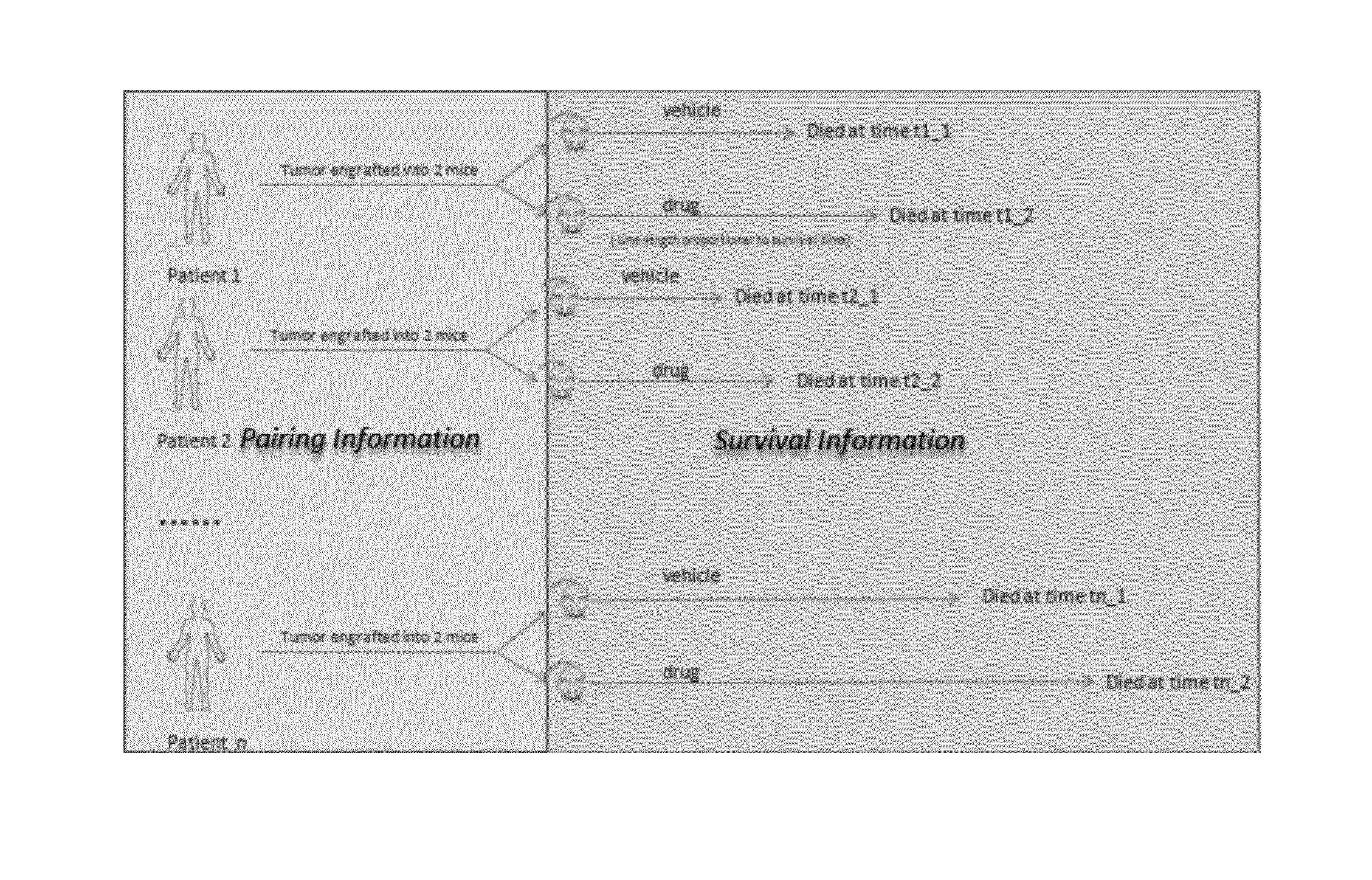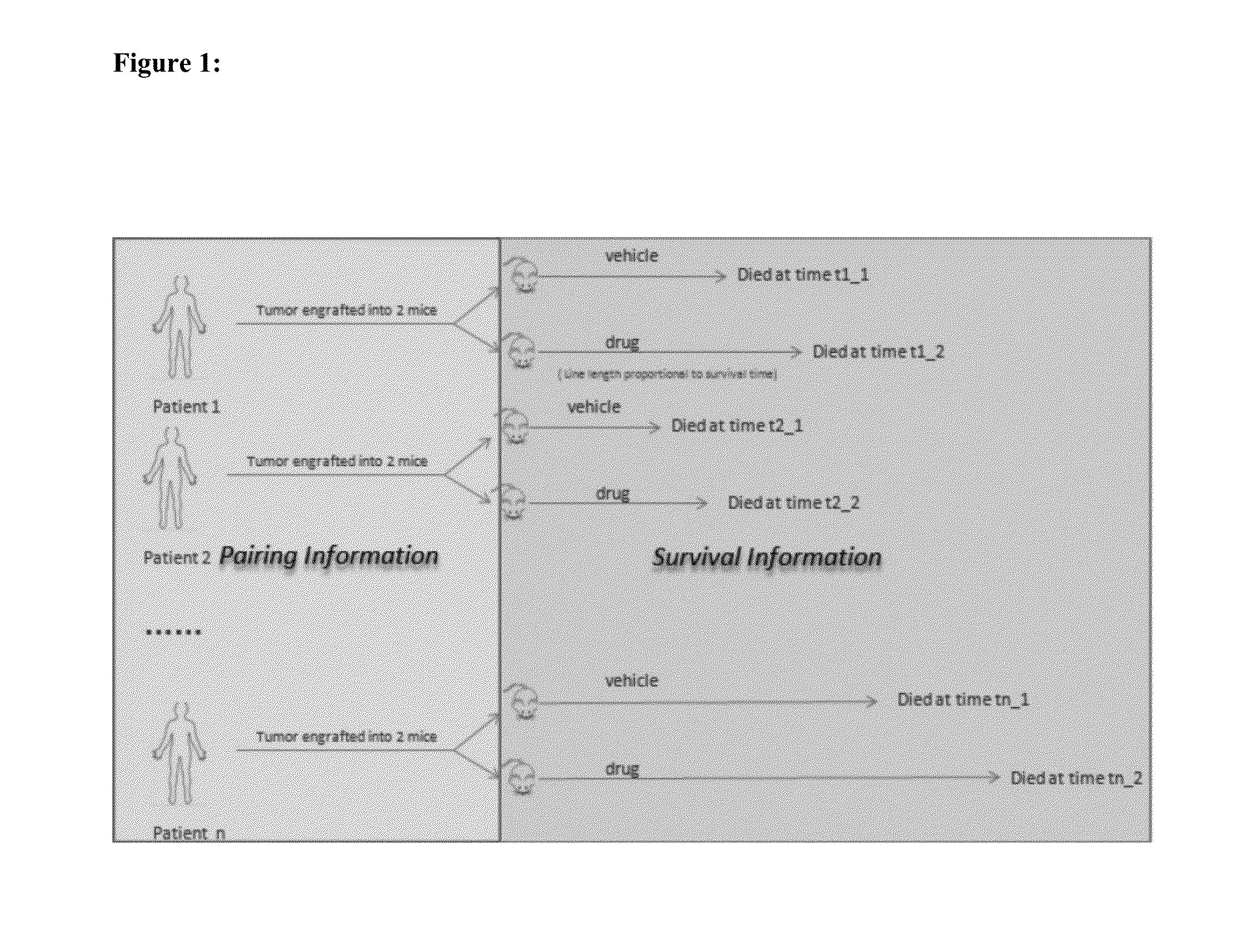Method for mimicking human clinical trial by using non-human animals
a human clinical trial and non-human technology, applied in the field of human clinical trial mimicking by using non-human animals, can solve the problems of unmet needs for reliable and efficient results
- Summary
- Abstract
- Description
- Claims
- Application Information
AI Technical Summary
Benefits of technology
Problems solved by technology
Method used
Image
Examples
example 1
[0056]In an MCT of 40 PDXs with 10:10 design (i.e., 40 PDXs is used and, for each of the 40 PDXs, there are 10 mice in the control group and 10 mice in the treatment group), a simulation by randomly drawing n (1≦n≦9) mice from both groups for each PDX was performed. The deviation of ΔT / ΔC from that in the 10:10 design was calculated, which was repeated 1000 times to generate distributions of ΔT / ΔC difference.
[0057]The simulation result is shown in FIG. 2. Based on the MCT, the inventors found that (1) ΔT / ΔC difference has quite large variation in the 1:1 design, and quickly decreases when more mice are added for each PDX model; (2) for the same n:n design, ΔT / ΔC difference is smaller for more potent drugs on the same set of PDX models.
example 2
[0058]MCT is different from the human clinical trial, since cells or tissues from one human subject may be grafted into multiple non-human animals (e.g., one is grafted into one mice in the control group and is grafted into one mice in the treatment group). Therefore, the end point between non-human animals that is grafted with cells or tissues from the same human subject is usually correlated and cannot be ignored.
[0059]However, ordinary log rank test used for human clinical trial ignores the pairing end point (not using the pairing end point), and reduces power. Considering the pairing end point, the sample number can be calculated through a modified formula.
K=(z1-α / 2+z1-β)2p1p2γ2[1-ρ]K=(z1-α / 2+z1-β)2p1p2γ2PairedSurvivalAnalysisUnpairedSurvivalAnalysis
Wherein K is the sum of the number of control non-human animals in the control group and the number of treatment non-human animals in the treatment group, α is type I error rate, 1-β is power of statistic, Zm is the mth quantile of a...
example 3
[0061]Based on the modified formula and preliminary experiment, the inventor designs a MCT. In the MCT design, α is set as 0.01, power of statistic is set as 0.99. According to the MCT design that the amount of the mice in the control group equates to that in the treatment group, P1 is 1 / 2 and P2 is 1 / 2. Based on the preliminary experiment and the predicted hazard of the texted agent, ρ is 0.3 and the hazard ratio is 0.65. Through the above formula, the K is calculated as 363. In view of that some mice may be censored during the MCT or some mice may never reach the end point during the MCT, the total amount of mice is set as 400. Based on the MCT design, both of the number of the mice in the control group and treatment group are 200. Considering 20 PDXs are required, 10 mice in the control group and 10 mice in the treatment group are grafted with each PDX. Therefore, MCT is a MCT of 20 PDXs with 10:10.
[0062]In contrast, if paired end point is not considered, i.e., using unpaired sur...
PUM
| Property | Measurement | Unit |
|---|---|---|
| Fraction | aaaaa | aaaaa |
| Volume | aaaaa | aaaaa |
| Distribution | aaaaa | aaaaa |
Abstract
Description
Claims
Application Information
 Login to View More
Login to View More - R&D
- Intellectual Property
- Life Sciences
- Materials
- Tech Scout
- Unparalleled Data Quality
- Higher Quality Content
- 60% Fewer Hallucinations
Browse by: Latest US Patents, China's latest patents, Technical Efficacy Thesaurus, Application Domain, Technology Topic, Popular Technical Reports.
© 2025 PatSnap. All rights reserved.Legal|Privacy policy|Modern Slavery Act Transparency Statement|Sitemap|About US| Contact US: help@patsnap.com



